Hello, art lovers! Want to showcase your creative works and attract more customers to your artisan business? Our guide to the top 19 artisan websites is here to help.
Our digital marketing team has meticulously evaluated the best artisan sites, taking into account factors such as design, functionality, uniqueness, and user experience. From visually stunning designs to in-depth knowledge about artisan products, these sites embody excellence in the artisan industry.
Not only will you find inspiration for your own artisan website, but also gain valuable tips on how to create an online presence that reflects your passion and creativity.
Bring some creativity to your artisan business with the help of this guide, and create an online presence that showcases the beauty and uniqueness of your handmade products! You’ll find website examples of handmade clothing, woodworking, pottery & ceramics, glassblowing, and jewelry businesses in this list! For examples within other industries, head over to our 2023 best websites article!
Top Artisanal Website Designs
1. Emily Jeffords
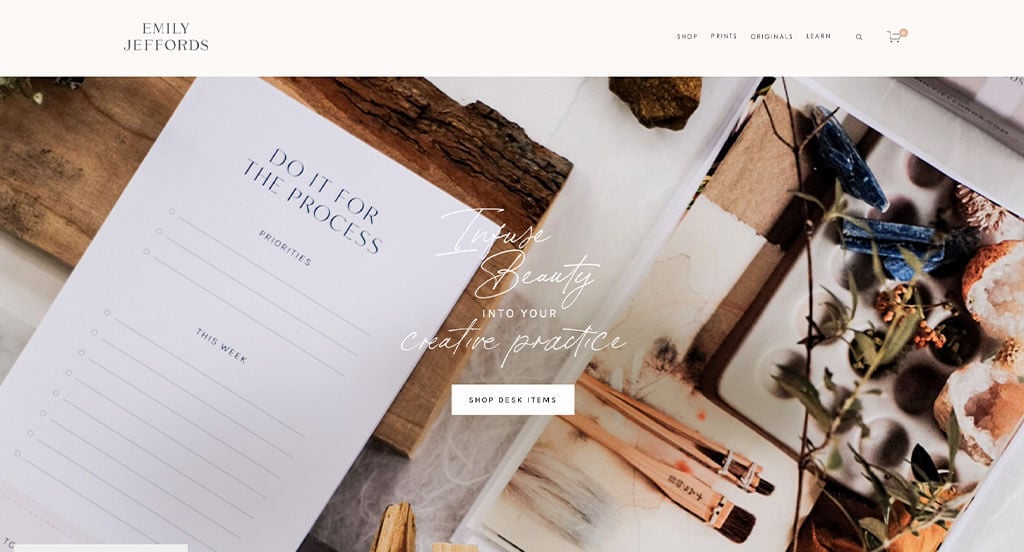
This is a good example of a web design for artisan companies who are looking for a custom look and feel for their next site. As you scroll through the homepage, one of the qualities you’ll notice right away is the relaxing color palette used throughout their site. This custom cleaning site also does a good job with the use of buttons throughout their site. They had digital marketing in mind when designing the stunning imagery used throughout their website. With so many quality reasons to consider this artisan website, it’s obvious why we included it in this list of the best sites!
2. Bowery & Grand

This is a great website design idea for an artisan company to review when looking for inspiration for custom website layouts. While most artisan websites share this quality, we thought Bowery & Grand did a nice job with their inclusion of videos. The well labeled navigation bar was another reason why we included this website in our list of the best website layouts for artisan companies. The domain for their website that matches the company’s name helped make this one of the top artisan websites we looked at. Don’t scroll past this website when considering design ideas for your next artisan website!
3. Alexander Designs
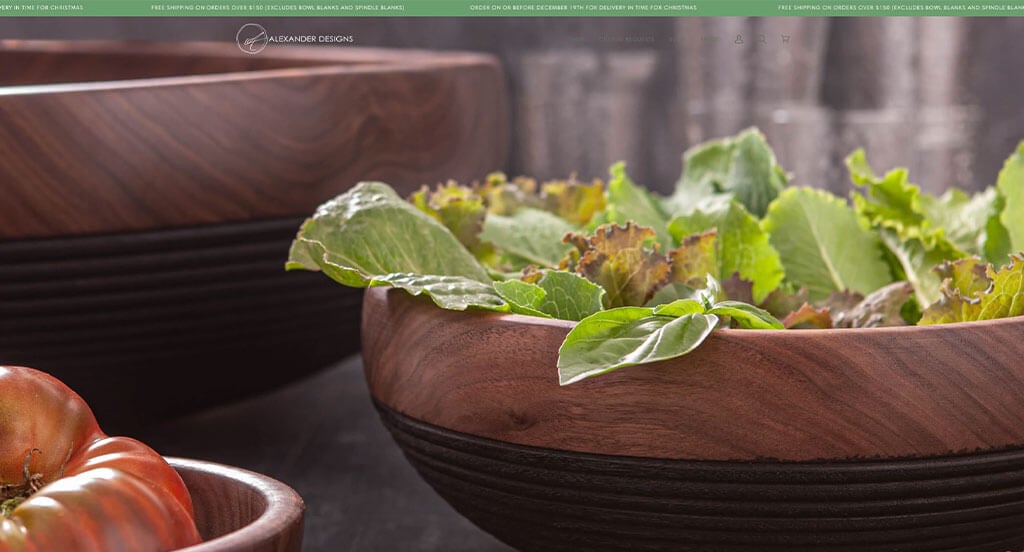
The black, white and brown color palette seen in this artisan website stood out to us because it creates a simple design. The bold font for their titles was probably the most impactful quality in the homepage of Alexander Designs. The stunning products were another feature in this professional artisan site we enjoyed. Alexander Designs had conversions in mind when designing the customer review section for their website. Give some thought to the one-of-a-kind design of this artisan website when developing your next custom website.
4. Aurora Shoe Co.

This is a great artisan web design example for someone who is looking to develop a professional website. Our web designers thought this was a good example of a homepage layout for artisan companies because of their creative color scheme. The inclusion of a blog was a unique choice for a custom artisan site. Aurora Shoe Co. clearly had website marketing in mind when incorporating social media into their website. These were just a few of the numerous qualities in this website we had to consider when putting together this list of top websites for artisan companies.
5. Farmhouse Pottery

The basic color palette in colors of this custom artisan website stood out to us because it creates a natural feel. Of all the custom websites we reviewed, one of the features in this custom website we liked was their high-quality visuals. The well organized template was definitely refreshing for a professional artisan site. Their use of buttons to help clients navigate the site helped make this one of the best artisan websites we reviewed. Be sure to consider the great design of this custom website when building out your next website.
6. General Store

Sporting a clean and intuitive layout, this site keeps things simple for an artisan website. We thought this was a good example of a homepage layout for an artisan company because of their large and stunning imagery. The variety of products was a unique choice for a professional website. They clearly had a focus on website usability when building the captivating font for their website. What a great website to review when building out your next artisan website!
Related: Boutique storefronts often use digital marketing to help promote their business online.
7. Melitta

The Melitta website has a very professional feel to it, thanks to its unique use of black, white and gold. After scrolling past the navigation of this artisan site, you’ll immediately notice the automatically playing video that captures viewers attention right away. The layout that doesn’t feel crowded was another thoughtful feature in this custom artisan site we enjoyed. They had internet marketing in mind when designing the high-quality visuals used in their website. If you are looking for template options for your next artisan site, give some thought to this one.
8. Whiskey & Clay

This is a good example of a website layout for an artisan company to check out when looking for inspiration on their next custom web design. The products that filled up the page was likely the most impactful feature in the homepage of Whiskey & Clay. The ability to read about the creators was absolutely a consideration when ranking Whiskey & Clay in this list of the best artisan websites. They clearly had website usability in mind when designing the domain for their website that matches their company’s name. For artisan companies looking for ideas for their next website, this example will definitely be one to keep in your back pocket.
9. Meredith Steele
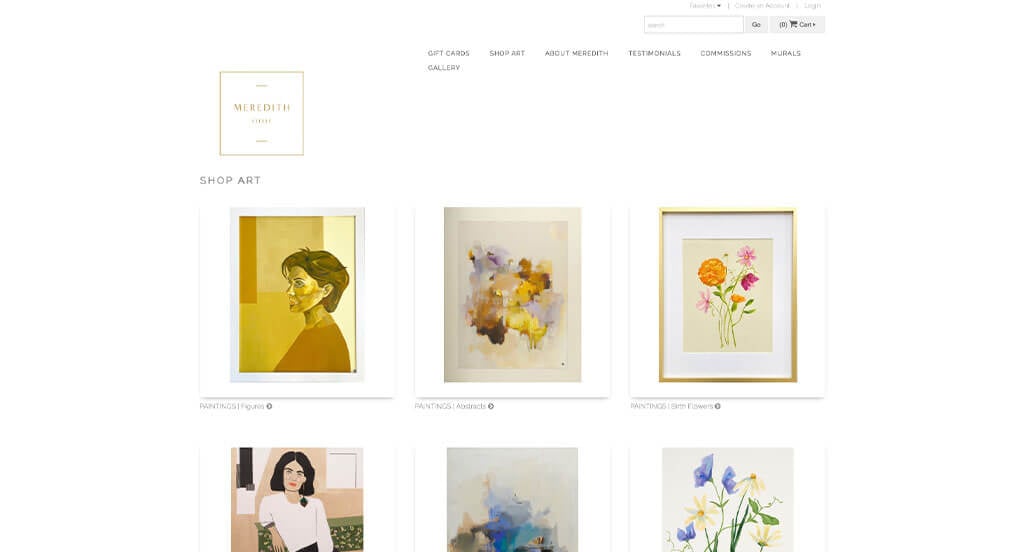
This is a good example of a website for an artisan company that is looking custom web design layout ideas. The subtle animations were probably the most impactful feature in the homepage of Meredith Steele. Another thoughtful feature in this creative artisan site was their use of a periwinkle accent. They clearly had website usability in mind when designing the inclusion of a shop into their website. Give some thought to the one-of-a-kind design of this artisan website when developing your next custom website.
10. iGourmet

Our team liked the red and white color scheme used in the iGourmet website, which we liked because it creates a simplistic design. The use of a search bar was probably the most impactful feature in the homepage of iGourmet. The imagery to help navigate through their site was another reason why we included this website in our list of the best website ideas for artisan companies. They clearly had conversions in mind when building the clearly labeled menu in their website. With so many good reasons to consider this artisan website, it’s obvious why we included it in this list of the best websites!
11. Verve Culture

We chose Verve Culture because of its nicely organized artisan website that uses a natural color scheme. The look and feel of the homepage of this artisan website caught our attention because of their professional font choice. The inclusion of social media was another reason why we included this website in our rankings for the top web design ideas for artisan companies. Verve Culture clearly had a focus on digital marketing when building the domain for their website that matches their company’s name. Don’t skip past this website when hunting for design ideas for your next artisan website!
12. White Oak Pastures

This is a great web design example for artisan companies who are looking for a professional layout. We thought this was a good homepage design example for artisan companies because of their relaxing logo design. The menu arranged into categories was another unique quality in this custom artisan site we enjoyed. White Oak Pastures clearly had a focus on website accessibility when creating the page for their sale and featured products in their website. Be sure to consider the creative design of this artisan website when developing your next custom website.
13. Thos. Moser

Showcasing a clean and intuitive layout, this website keeps things simple for an artisan site. As you scroll through the homepage, one of the design qualities we liked was their stunning color choice. Their use of buttons to enhance usability was a unique choice for a custom site. Thos. Moser clearly had conversions in mind when creating the high quality imagery in their website. What a great website to review when building out your next artisan website!
14. Vintage Mill Werks
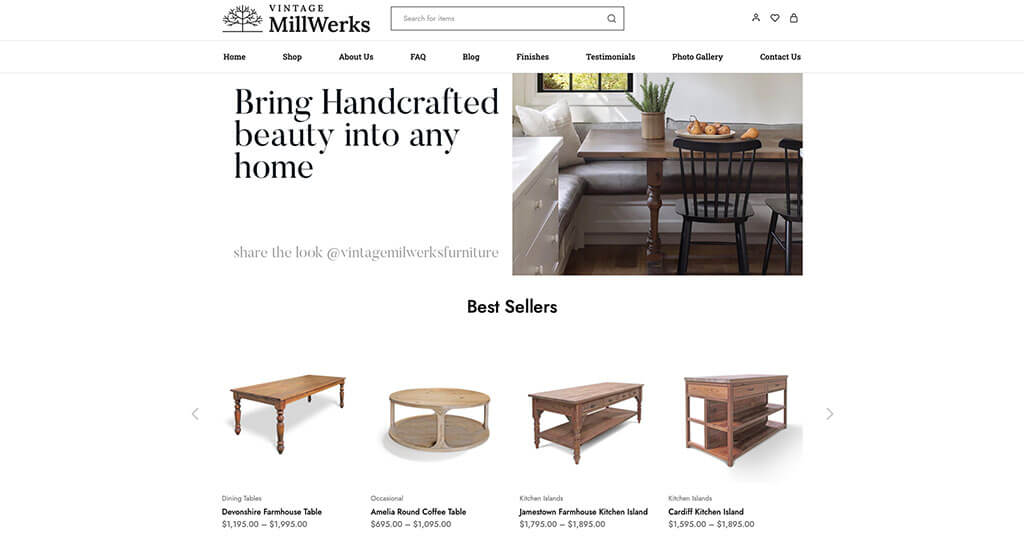
Vintage Mill Werks has a well-designed artisan website that uses a black and white color palette. We thought this website was a good example for artisan companies because of their ability to add products to a wishlist. The inclusion of a blog was definitely refreshing for a custom artisan website. Vintage Mill Werks had internet marketing in mind when building the photo gallery for their products in their website. If you are looking for template ideas for your next artisan website, be sure to check this one out.
15. Gat Creek

This is a great website design example for artisan companies who are looking for a custom website. Our web designers thought this was a good example of a homepage layout for artisans because of their layout that was easy to follow. This clean artisan site also does a good job with their simple checkout process. They had ease of use in mind when creating the large imagery in their website. These were just a few of the numerous qualities in this website we had to consider when putting together this list of top websites for artisans.
16. Clay and Craft
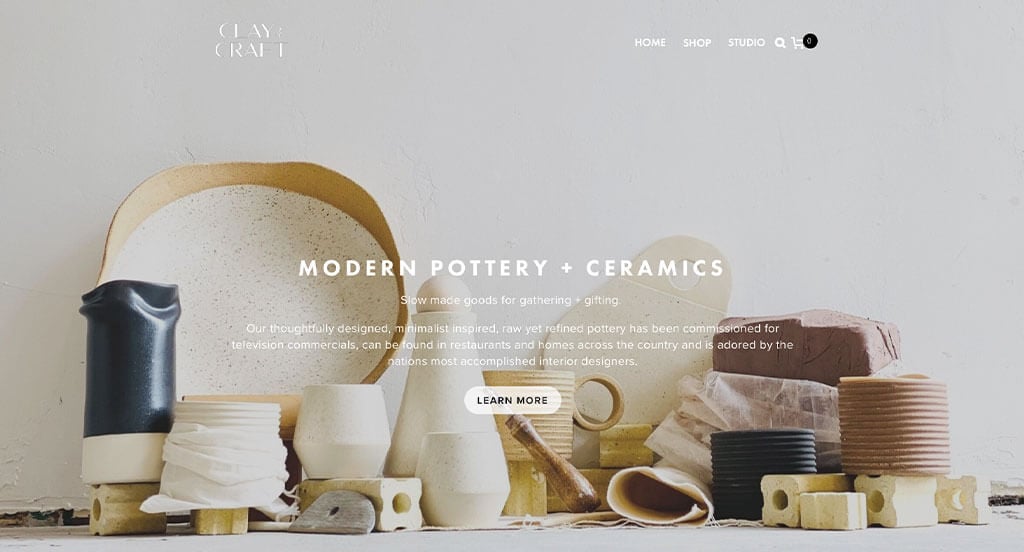
The natural color palette used in this site stood out to us because it matches their company theme. We thought this website was a good design idea for artisans because of their accented fonts. The layout that was aesthetically pleasing was another design quality in this professional artisan site we enjoyed. Clay and Craft clearly had a focus on digital marketing when building the simple contact information for their website. Give some thought to the one-of-a-kind design of this artisan website when developing your next custom website.
17. Ephraim Pottery

This is a good example of a web design for artisan companies who are looking for a custom look and feel. Of all the artisan websites we reviewed, one of the features in this custom website we liked was the basic color scheme to emphasize their products. Another feature in this clean artisan site was their well organized shop. Ephraim Pottery had conversions in mind when creating the clearly labeled pricing for their website. For artisans looking for examples for their next website layout, this example will for sure be one to take a look at.
Related: Do you sell a product that is highly searched online? It might be worth it to invest in search engine optimization to get traffic to your product pages!
18. YONOBI
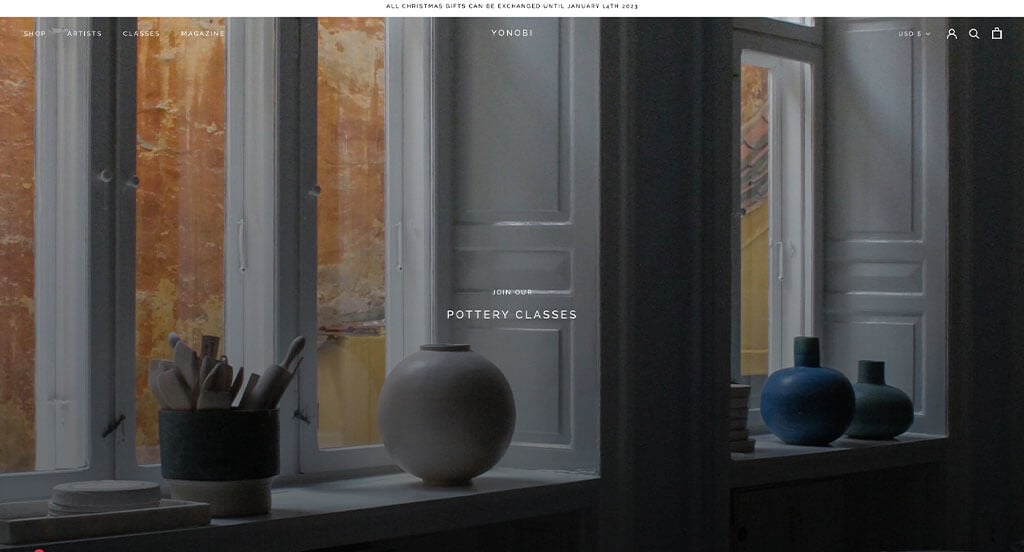
This is a great example for artisan companies that are looking for a professional website layout. The large imagery was probably the most impactful feature in the homepage of this website. Another thoughtful quality in this clean artisan website was their organization to search for gifts by price range. They had digital marketing in mind when designing the magazine page for their website. Be sure to consider the creative design of this artisan website when building out your next website.
19. Prosperity Candle
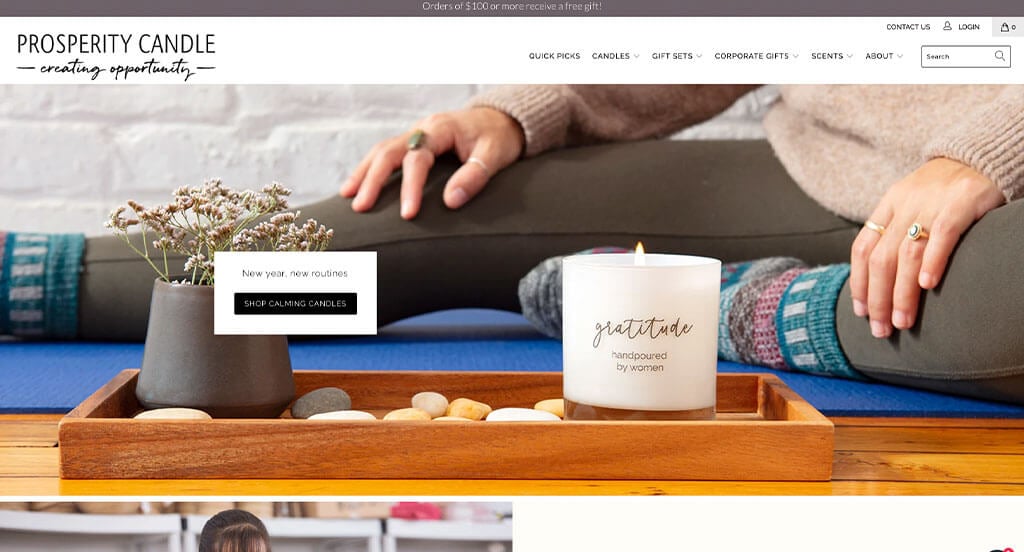
We liked how this artisan site combined the colors of black, white and dull pink to create an attractive website layout. We thought this was a good example of a homepage layout for artisans because of their use of buttons to navigate throughout their site. The different font for their titles was refreshing for a custom site. They clearly had ease of use in mind when building the domain for their website that matches their company’s name. Any website designer mocking up websites for artisan companies will want to consider checking this website out.
How to Build a Great Artisan Website
Are you in the process of building a new website for your artisan business? How exciting!
Let’s walk through some of the most important steps in building a new, or redesigning an existing, artisan website.
Feel free to skip the first few sections if you already have a domain name, hosting service, and website platform picked out!
1.) Purchasing a Domain Name
Picking out a domain name for your artisan website is a crucial step in establishing your online identity. It serves as the address that visitors will use to access your website, and it plays a significant role in branding and recognition of your business.
Here’s a step-by-step process to help you choose the perfect domain name:
- Brainstorm: Start by thinking of ideas for your domain name, considering the name of your business, the type of artisan products you offer, and your niche.
- Simplicity: Try to keep your domain name simple, easy to spell, and pronounce. Avoid using complex words, hyphens, or numbers.
- Consistency: If your business has an established brand name, it’s generally a good idea to include it in your domain name. For example, if your business name is Jill’s Ginger Artisan Crafts, don’t register a domain name such as GoldAndSilverDecor.online.
- Availability: Check the availability of your desired domain names before proceeding. Most common domain names have already been purchased. If that is the case, see if your desired domain name is not being used and is available for sale. Just don’t invest too much money in buying a domain name.
- Domain Extensions: Consider which domain name extension best suits your website’s purpose. While .com is the most common and widely recognized extension, there are many other options available, such as .net, .org, or industry-specific extensions like .crafts.
- Legal Considerations: Before registering your domain name, it’s important to conduct a trademark search to ensure that your chosen name doesn’t infringe upon someone else’s intellectual property. For example, don’t register a domain name that includes another artisan business’s name or the name of a popular artisan marketplace.
- Register the Domain: Once you’ve settled on an available domain name, it’s time to register it through a reputable domain registrar. We’ve found GoDaddy and Namecheap to be the easiest to manage domain name registrations.
2.) Choosing a Website Platform
After figuring out your domain name, the next step is selecting a website platform for your artisan website.
Most artisans are going to build ecommerce websites with the ability to buy their wares online. These types of businesses often launch their products on Etsy and Shopify, but WooCommerce is also a popular platform..
- WooCommerce: If you plan to build an online store for your artisan business using WordPress, WooCommerce is the perfect ecommerce plugin to install. It seamlessly integrates with WordPress, allowing you to add ecommerce functionality to your existing artisan website. WooCommerce offers a wide range of extensions, payment gateways, and inventory management tools, making it an ideal choice for artisans looking to sell their products online.
- Shopify: The Shopify platform is a leading ecommerce solution that provides everything you need to create and manage an online artisan business. It is a hosted ecommerce platform, which means you don’t need to find a separate web hosting service to use it. Like other ecommerce solutions, it offers a user-friendly interface, customizable themes, built-in security, and a range of features for inventory management, payments, and shipping.
Web Hosting Requirements
If you choose a platform like WordPress or WooCommerce, you’ll need to find a web hosting service.
As a shameless suggestion, we often recommend our own web hosting service because of how well it performs for WordPress websites. However, if you prefer recommendations from other hosting companies, consider the following options:
- WP Engine: This is one of our favorite web hosting services for artisan businesses. WP Engine provides a great control panel that makes it easy to create staging websites. Their backup process is also seamless. The only downside we’ve noticed is the limits they place on PHP max_execution_time. Keep in mind that their pricing can increase quickly if you require upgraded services.
- SiteGround: We’ve always enjoyed working with SiteGround. Their live chat and email support are excellent compared to more well-known hosting firms. We’ve never had to wait long to get in touch with someone, and the first person we’ve interacted with typically solves the issue. Their backup tools are very user-friendly, and they offer reasonable pricing for artisan businesses.
3.) Selecting a Website Template
Many artisans prefer to purchase and customize pre-built website templates as it reduces both the cost and time involved in web development. However, if you prefer a custom design, you can always hire a professional web designer or custom ecommerce developer to create a unique theme specifically tailored to your artisan business.
To guide you in setting up your artisan website, let’s focus on suggestions for finding pre-built website templates. Here are some links to the main theme marketplaces you should consider:
WooCommerce Artisan Themes
You’ll find plenty of ecommerce themes for artisans compatible with WooCommerce on ThemeForest.
Creator – Themeforest
$79

Manufactura – Themeforest
$69
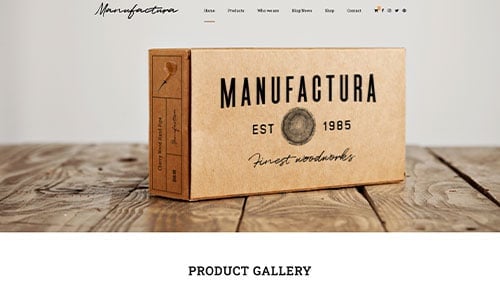
Craftis – Themeforest
$69
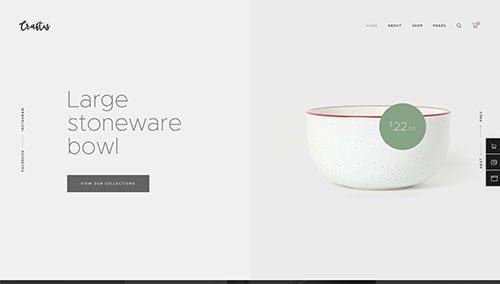
Iona – Themeforest
$69
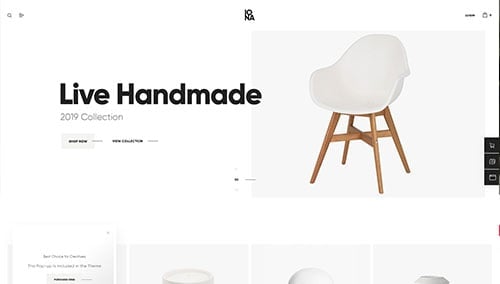
Shopify Artisan Themes
Discover free and paid themes at themes.shopify.com or explore options on marketplaces like ThemeForest.
Handart – Themeforest
$56
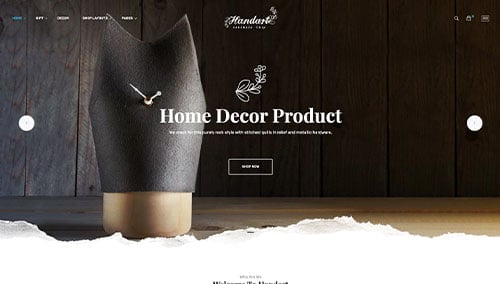
Ap Mixmart – Themeforest
$56

Mintie – Themeforest
$59
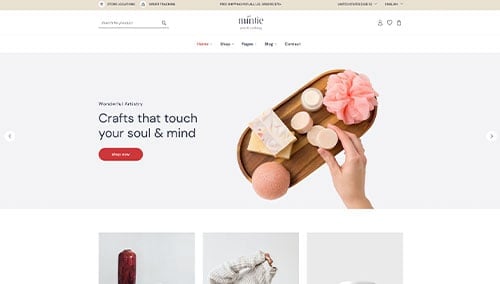
Leatic – Themeforest
$56

Wix Artisan Themes
Discover free and paid themes in their marketplace at wix.com, some of which are perfect for artisan businesses.
4.) Crafting Content & Adding Visuals
Now that you have your domain name, website platform, and theme sorted out, it’s time to start developing compelling content for your artisan website!
There are several strategies you can employ to create engaging and impactful website copy. Let’s explore a few:
- Know your target audience: Before writing a single word, gain a deep understanding of your target audience. Identify their demographics, preferences, and needs. Tailor your content to address their pain points, provide value, and resonate with them. This will help your artisan business rank higher in search engine results for relevant queries.
- Define your key messages: Determine the main messages you want to convey through your website content. These messages should align with your brand, highlight your unique selling points, and clearly communicate the benefits of your artisan products or services.
- Keep it concise and scannable: Online readers tend to skim content, so ensure your writing is concise and easy to digest. Use short paragraphs, bullet points, subheadings, and bold text to break up the content and improve readability.
- Create clear and captivating headlines: Craft attention-grabbing headlines that instantly convey the value and relevance of your artisan business. A well-crafted headline can entice visitors to explore your website further and learn more about what you offer.
- Incorporate keywords strategically: Conduct research to identify relevant keywords and naturally incorporate them throughout your content. This can enhance the visibility of your artisan website in search engine rankings. However, avoid excessive keyword usage, as it can negatively impact readability and user experience. Consider using tools like Ahrefs or Semrush for keyword research.
- Maintain a conversational tone: Write in a conversational style that resonates with your artisan audience. Avoid jargon or overly technical language unless it’s necessary for your specific audience. Engage your readers by addressing them directly and adopting a friendly and approachable tone.
- Edit and proofread: Always edit and proofread your content before publishing. Check for grammar, spelling, and punctuation errors. Ensure the flow of your content is smooth, logical, and aligned with your brand voice and style guidelines. Consider using tools like Grammarly for assistance!
- Leverage AI tools like ChatGPT: If you need help generating ideas or refining the content on your artisan website, consider utilizing AI tools like ChatGPT.
Break up long sections of text by incorporating relevant and high-quality images into your content. Consider the following tips:
- Opt for high-quality visuals: Choose high-resolution images that are visually appealing and well-composed. Blurry or pixelated images can detract from the overall quality of your artisan website.
- Ensure relevance: Select images that are relevant to your content and effectively illustrate your message. Your images should enhance the text and provide additional context or visual interest to showcase your artisan work.
- Explore stock photo resources: Utilize reputable stock photo websites such as Unsplash, Pixabay, or Shutterstock to discover a wide range of professional-quality images relevant to your artisan craft. Ensure compliance with licensing requirements and attribute images as necessary.
- Customize images when possible: If you have the skills or resources, consider customizing or branding images to align with your artisan brand. This can help create a cohesive visual experience for your visitors. Tools like Adobe Photoshop or Canva can assist you in this process.
- Optimize image file sizes: Compress images to optimize file sizes without compromising quality. Large image files can slow down your artisan website’s loading speed, affecting user experience and SEO. Tools like TinyPNG can help with image compression.
5.) Post Launch Strategies
Once you have built and launched your artisan website, there are several important tasks and services to consider in order to maximize its effectiveness. Here are some essential suggestions to help you navigate post-launch activities:
- Search Engine Optimization (SEO): Implementing effective SEO strategies is crucial for improving the visibility of your artisan business in local search results. Conduct thorough keyword research, optimize your content, and ensure your website has a solid internal linking structure. Regularly update your website with fresh, high-quality content to attract organic traffic. You may also consider utilizing the services of our SEO team or exploring third-party providers like The HOTH.
- Paid Advertising: For faster traffic growth, consider leveraging paid advertising platforms such as Google Ads or Facebook Ads to drive targeted visitors to your artisan business. You can opt for our PPC management services or find skilled professionals on platforms like Mayple.
- Conversion Rate Optimization (CRO): Analyze your website’s performance and user behavior using tools like Google Analytics. Identify potential drop-off points and barriers to conversion. Conduct A/B testing with tools like VWO to make data-driven improvements that enhance your website’s conversion rates and overall user experience.
- Website Security: Safeguard your artisan website against malware and other security threats. Implement robust security measures such as SSL certificates, web application firewalls (like Sucuri), and regular backups. Keep your CMS, plugins, and themes up to date to minimize vulnerabilities. Monitor your website for potential risks and promptly address any security issues. It’s also advisable to monitor website uptime using a service like UptimeRobot.
- Website Maintenance: Regularly maintain your artisan website to ensure optimal performance. If you’re using a platform like WordPress, this includes updating plugins and themes, monitoring website speed and performance, and resolving any broken links or errors. Consider our website maintenance services or hire a freelancer from Upwork for assistance. Regularly back up your artisan website to safeguard against data loss or technical issues.
- User Feedback and Testing: Actively seek user feedback to understand visitor experiences and identify areas for improvement. Implement user testing to gain insights into how users interact with your artisan website. Use this feedback to make iterative enhancements and continuously optimize the user experience.
- Content Updates: Keep your website content fresh and up to date. Regularly publish new blog posts related to your artisan craft, update product or service information, and ensure all content is accurate and relevant. Engaging and valuable content not only attracts visitors but also encourages them to return and share your content with others interested in artisan crafts.
Remember, post-launch digital marketing activities are crucial for the long-term success of your artisan website. Stay proactive, monitor performance, and adapt your strategies to achieve your business goals and meet the needs of your audience.